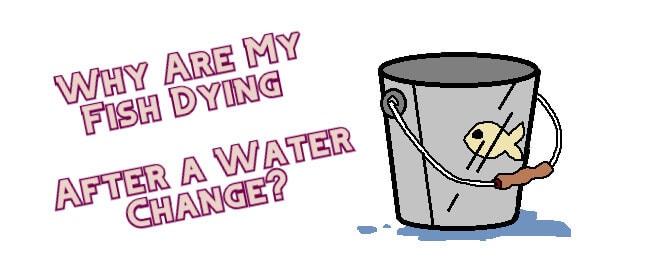Cleaning your aquarium and maintaining it in good shape is essential for its long-term success. But then why do fish suddenly die or get very stressed after a water change?Changing the water in the tank should be a good thing and not lead to shock or fish deaths. Or should it? So why are your fish dying right after you’ve changed the aquarium’s water?

Truth is, there’s more than one thing that could go wrong when changing your tank water.
Why did your fish die or suffer after a water change?
Performing large or infrequent water changes in an aquarium may indeed kill the fish inside.
This however doesn’t mean you shouldn’t strive to maintain healthy water quality in the tank.
Water changes are beneficial to the aquatic inhabitants of the tank but only when they’re executed properly.
The main purpose of changing water is to remove Nitrate from the tank and also regulate the everfalling pH that results from the activities of different bacteria.
If your aquarium fish die after a water change it likely has to do with the sudden shift in water parameters:
Fish can adjust to gradual changes in their environment. However, changing a large portion of aquarium water may significantly alter the parameters of the remaining water inside the tank. The fish may not be able to adjust to the sudden shift in these parameters and may get severely stressed or even die as a consequence.
This could happen even with a smaller water change, as long as a considerable amount of time has passed since the last one.
Author’s note: Even if your pet fish don’t die immediately after you change their water, it’s a good idea to monitor their behavior for signs of stress. Any strange changes in their behavior can be the signs of a dying fish.
What water parameters changed so suddenly as to kill or stress your fish?
There are multiple things that could go wrong during a water change.
Here’s which water parameters may be responsible for your dying fish:
1. Nitrate levels were too high before you changed the water.

A high level of Nitrate in the aquarium water can be inherently toxic to fish and may even kill them.
However, the sudden drop of Nitrate levels that follows a water change could send your fish into Osmotic Shock.
Nitrates are ions (NO3-) and fish can gradually adapt to changes in the level of ions and ionic compounds such as salts in their environment.
The body of a freshwater fish contains more ions and ionic compounds than the water surrounding it.
This means that without bodily fluid regulations the surrounding water will try to get inside of the fish’s body while sucking the ions from it through a phenomenon called Osmotic Pressure. It’s why you never want to use distilled or purified water for water changes in your aquarium.
However, under normal conditions fish have a mechanism that protects them against this phenomenon.
The fish’s ability to counter osmotic pressure is called Osmoregulation.
Here’s an illustration of how Osmoregulation works in freshwater fish:
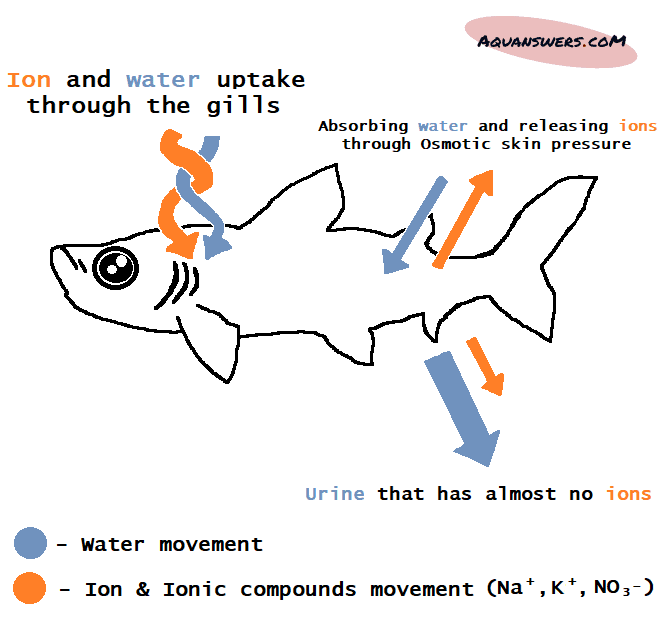
Osmotic Pressure works both ways and changes directions when it comes to saltwater fish. A saltwater fish regulates its body in a way that prevents it from absorbing too many salts from the water since the water contains more ions than its body (salts are ionic compounds).
Osmotic shock is the condition where the body of a fish fails to regulate its absorption of ionic compounds and starts to either absorb or release too much fluid as a consequence. Osmotic shock may be the reason why fish suffer when you remove a large portion of the Nitrate ions through changing the water in their tank.
When in Osmotic shock following a water change, freshwater fish will hold too much fluid, which may lead to swelling of their organs, a condition known as Dropsy. The swollen organs could put pressure on the swim bladder of the fish which may lead to it swimming upside-down or sideways.
In fact, impaired osmoregulation is often the reason behind a bloated Betta fish. Impaired osmoregulation may also explain why your fish are swimming erratically and acting stressed after a water change.
This weird behavior may even be accompanied by spasms.
To find out whether the drastic change in Nitrate stressed your fish you could use a liquid water test kit before and after replacing the aquarium water.
To avoid stressing or killing your fish with Osmotic shock, change no more than 10% of the water in the tank. If you need to exchange a larger portion of water, wait about an hour or so between the partial water changes.
Only an emergency such as some harmful compound quickly raising justifies large water changes.
Even then it’s recommended to do two replacements of 20%, 1 hour apart, instead of a single 40% one.
Related:
2. The temperature of the new water was too low for the aquarium.

If the temperature of new water does not closely match the one in the aquarium your fish may easily fall sick and die after a water change.
It’s why most disease outbreaks in aquarium fish happen in Spring and Fall when the temperature difference between day and night is greater.
Fish are cold-blooded creatures and do not regulate their body temperature.
They are what is known as Ectotherms which means that their bodily functions are entirely dependent on outside temperatures.
When you perform a water change with colder water, the fish in your aquarium go into a thermal shock, which leaves them extremely vulnerable to disease.
A fish that goes through thermal shock will not move a lot, lose its color quickly, and may die almost immediately after a water change. Consequently, the immune system of the fish that survive may be compromised.
They may now be susceptible to various diseases that their bodies were able to fight off when in good health.
The temperature fluctuations of water are often the reason behind large parasitic Ich outbreaks which can be difficult to treat in freshwater inhabitants and even more so in saltwater ones. These parasites are present in the water most of the time but, typically, a healthy fish can handle them on its own.
To avoid fish deaths due to thermal shock you should perform water changes with water that has been heated beforehand.
Suggested read: 17 Best Fish for a Cold Water Aquarium
3. You forgot to add a Dechlorinator or added it too late.

If you’re not using a dechlorinator before putting tap water in your fish tank, you’re asking for trouble. Tap water usually contains either Chlorine or Chloramine.
Both of these are lethal to fish and can kill almost everything in your aquarium.
So use a good dechlorinator when doing water changes to avoid killing your fish.
Anyway, when some aquarists change the water in their aquarium they first put the new water in the tank and then add the dechlorinator.
This way they risk harming their fish because even the best dechlorinator takes time to neutralize Chlorine and Chloramine.
Given that you follow the dechlorinator’s instructions, Chlorine is usually neutralized in less than a minute. However, most water facilities prefer using Chloramine for water disinfection, because it has a more stable chemical bond and evaporates much slower.
A good dechlorinator may take up to 5 minutes to neutralize all of the Chloramine in a given amount of water.
In larger tanks, adding the new water before the dechlorinator may not cause a lot of trouble.
In smaller tanks, however, the consequences of the change could be deadly for your pet fish.
Another thing that I don’t see many considering is that Chlorine and Chloramine are bacteria killers by definition. Pouring chlorinated water in your aquarium during a water change may wipe out most of the beneficial bacteria responsible for the system’s ongoing Nitrogen cycle.
The Nitrogen Cycle is the process in which these bacteria transform deadly compounds such as Ammonia and Nitrite in the less harmful Nitrate. This means that there’s a good chance that an Ammonia or Nitrite spike may follow immediately after changing the water in the fish tank with chlorinated water.
Ammonia and Nitrite poisoning harm the gills of fish, which leads to respiratory stress. This may be the reason you’re seeing your fish dying and gasping at the top or the bottom of your new tank, right after a water change.
To avoid wiping out the biofilter in the tank or poisoning your fish with chlorinated water, dechlorinate the new water before putting it in the tank. Also, know that if you’re using water that has gone through a RO / DI system for your aquarium’s water changes there’s a chance that the RO / DI filter will not remove Chlorine or Chloramine entirely.
4. Your water conditioner has caused an ammonia spike or depleted the available oxygen.
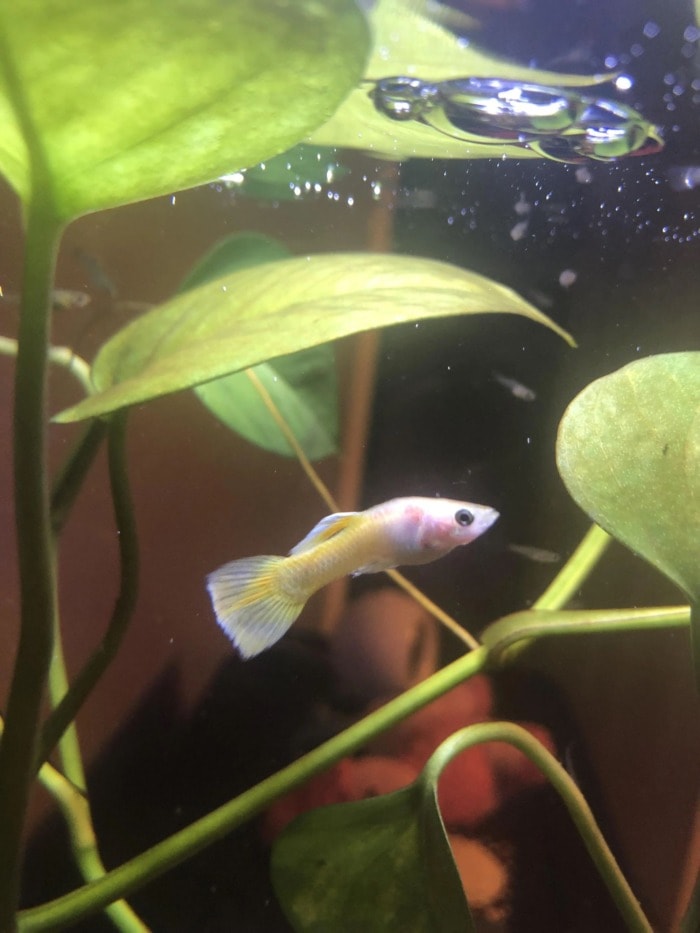
Water conditioners purify tap water by using special chemicals that bind to chlorine.
The resulting chemical process consumes small amounts of oxygen, which typically doesn’t affect fish.
That is unless the oxygen in the aquarium system is low to begin with.
In such cases, overdosing the water conditioner might deplete the available oxygen and kill the fish in the tank.
And even though you can accidentally suffocate your fish by using too much water conditioner, this can only happen if you exceed the recommended dosage by a fairly large amount. In most cases, it’s not the water conditioner that kills fish after a water change, but the spike in ammonia it causes.
When you use a water conditioner, it neutralizes chlorine by binding to it. And this includes the chlorine molecules in chloramine.
Since these molecules are bound to ammonia, the ammonia gets released into the water once the water conditioner takes effect.
Most commercial dechlorinators counteract the resulting spike by converting ammonia to the fish-friendly ammonium.
Some, however, don’t.
Seachem Prime is a great water conditioner that takes care of chlorine and chloramine, and detoxifies ammonia all at the same time.
It’s the go-to choice for most fish keepers, and it’s a product I’ve used many times over the years.
5. You vacuumed the whole substrate and/or changed the filter media.

The beneficial bacteria that live in an aquarium inhabit porous surfaces.
Both your filter media and the substrate are porous surfaces and an ideal breeding ground for these bacteria.
When you vacuum the whole substrate at once during a water change, you risk removing a large chunk of the bacteria’s population.
This may hinder the Nitrogen cycle in the fish tank, which can lead to a “tank crash”.
Anyway, changing all of the filter media is even more dangerous, as there are a lot of beneficial bacteria inhabiting that.
Counterintuitively, if you changed filter media while cleaning the tank it could cause Ammonia or Nitrite to spike and kill all of your fish very quickly. A good sign of a restarted Nitrogen Cycle would be when the water in your aquarium becomes cloudy white a couple of hours after you did the last water change or cleaning session.
To avoid killing your fish after cleaning their tank, rinse filter media in dechlorinated aquarium water and vacuum no more than 30% of the substrate per session.
6. There was too much saturated gas in your tap water.

When there’s too much saturated gas in the water, that gas wants to leave it immediately.
That’s because nature seeks its balance so that the pressure between the liquid and atmospheric air evens out. This results in tiny white bubbles forming on the glass and other surfaces inside your aquarium.
This effect could be dangerous to fish after you do a water change because gas bubbles could form in their blood, fins, and eyes.
The fish may die if bubbles are formed in its bloodstream, or lose eyesight if they form in its eye.
The gas saturation of a liquid depends on its temperature.
If you quickly heat up any water you will see these small bubbles forming inside its container, following the drastic change in temperature.
This is because warm water can hold less gas than colder water.
To avoid causing Gas Bubble Trauma to your fish, just stir the new batch of water well before doing a water change. Another effective method of releasing the saturated gases is by spraying the water from above the water surface of the aquarium, which will cause splashing.
Splashing and surface agitation are the best methods to stimulate gas exchange between water and atmospheric air.
What can you do to save fish that are dying right after a water change?
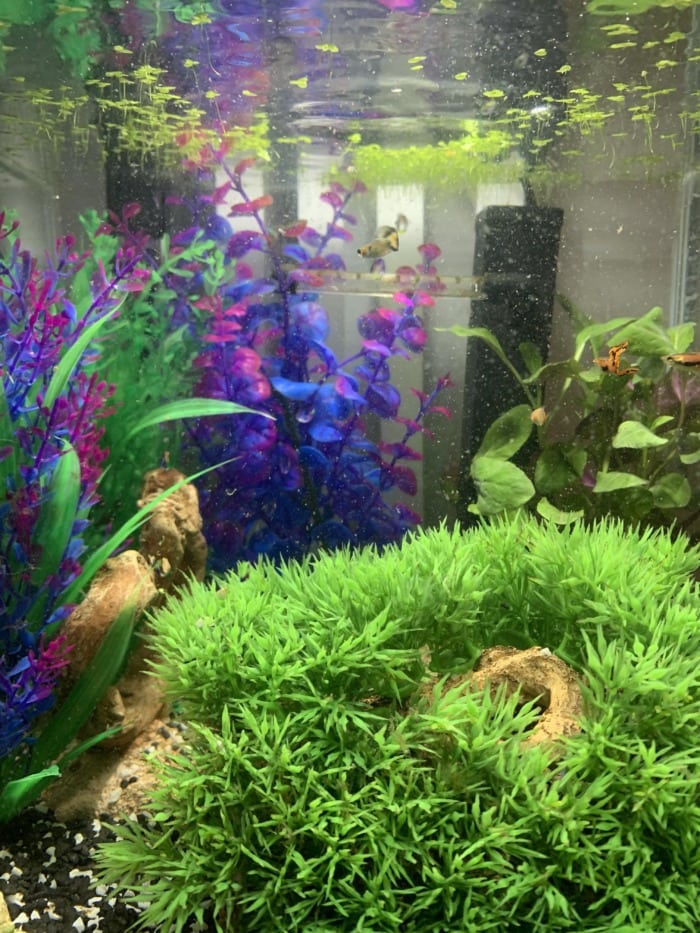
Unfortunately, there’s not much that you could do to save your dying fish after the fact. The water change has already altered the water’s parameters in the aquarium and your fish are suffering the consequences.
If wiping out beneficial bacteria turns out to be the problem you could pour in a bacteria-starting supplement in the water, which will take some time to take effect. These supplements will help your fish to deal with the shock from both Ammonia and Nitrite poisoning.
I recommend using Tetra SafeStart Plus in these cases (you can find it on both Chewy and Amazon). Aside from that the best way to help your fish further is by doing water changes the proper way in the future.
Unfortunately, some of your fish may die, and you’ll need to remove them from the tank immediately to avoid further issues with water quality.
Related: What to Do When You Find a Dead Fish in Your Tank
How to perform aquarium water changes without killing your fish?
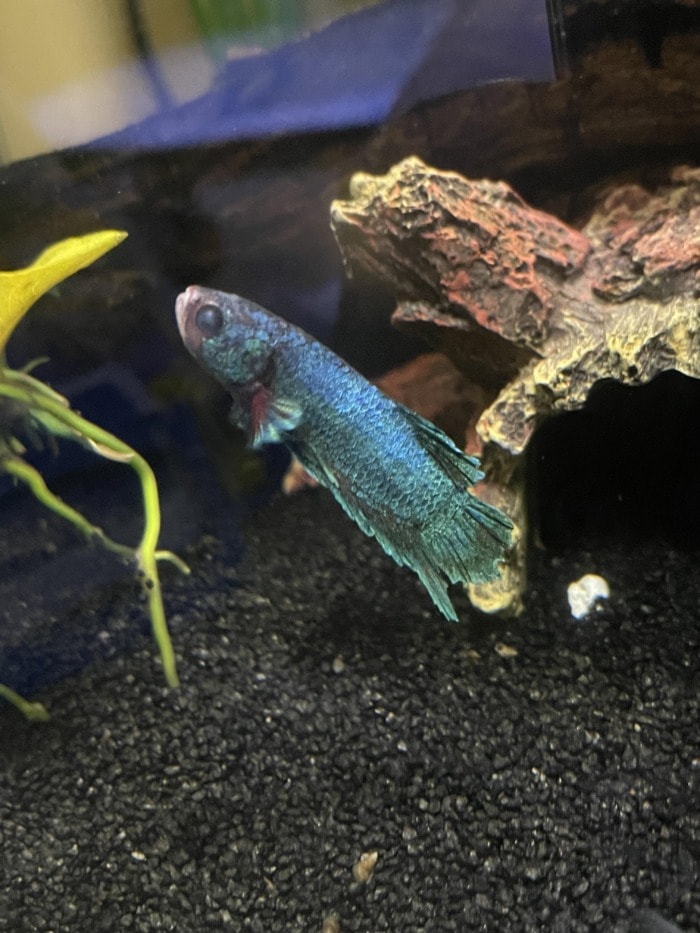
There are a few simple steps that you need to follow in order to avoid fish deaths after a water change.
The most important thing here is to take some proper preparations before putting the new water in the tank. You’ll need a bunch of inexpensive but essential equipment before you start:
- A container or a bucket to hold the water
- A small heater for aquarium use
- A water dechlorinator
With these items at hand, you can safely change the water in your aquarium.
Follow these exact steps, to perform a water change without the risk of killing your fish:
- Pour in the needed water quantity in a container. I usually use a bucket made of stainless steel or plastic.
Make sure the container you use is not made of something that contains copper, as that can be toxic to fish and invertebrates.
- Heat up the new water so that it matches the temperature of the aquarium. Use a small, adjustable heater to heat the water in the container.
If you use a preset heater in your main tank, you could use the same model for heating the new batch of water.
- Dechlorinate the water and wait for 5 to 10 minutes. This is done to allow some time for the dechlorinator to properly remove the toxic Chloramine.
- Stir the water in the container for about a minute. This way you help the gaseous exchange between water and air.
- Change no more than 10% of aquarium water per session. If you need to change more, wait for an hour or two so that your fish can safely adjust before the second batch of water.
Partial water changes will likely prevent all kinds of shock and stress for your pet fish.
Setting up a good water changing schedule helps a lot.
I usually do a water change before going to work and then another one in the evening.
If I decide there’s a need for more, I would do the third one the next morning. Also, having a lot of floating plants in your freshwater aquarium helps with keeping Nitrate in check and may even reduce the need for water changes in the long run.
If you run a saltwater tank with abnormally high Nitrates you should likely consider getting some inexpensive LED lights and growing Chaetomorpha algae in your refugium.
But how do wild fish adjust to water parameters when it rains?

Fish in the wild are subject to acidic or cold rain, so how did a simple water change cause havoc in your aquarium?
The answer lies in the massive volume of water they live in.
For example, in the wild Nitrate levels do not go above 2 ppm, because they get diluted in the vast body of water.
It is pretty much the same when it comes to rain.
The water parameters in the river or lake remain stable during rain, because of dilution. It should be noted that the hardiest fish in the aquarium hobby come from regions that experience severe weather shifts.
